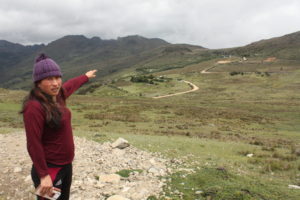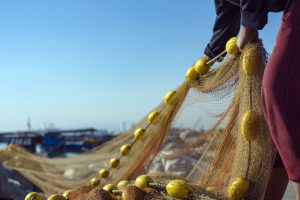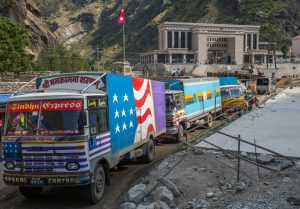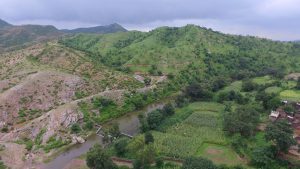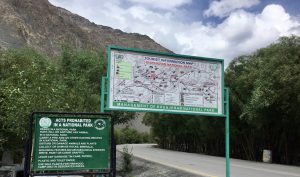The June-September monsoon is the peak fishing season in the Bay of Bengal for more than half a million poor Bangladeshi fishers. But this year, their wooden boats are still moored along the coast. For the first time, the government is enforcing an annual 65-day ban on all types of marine fishing for what the officials say is conservation of spawning fish and crustacean species. In protest, many crews of artisanal boats took to the street in May. Without other livelihood options, this ban will force them into more poverty and hardship, they said.
As of June 2019, Bangladesh has 253 trawlers — purpose-built to use trawl nets, owned by seafood industries and licensed to fish in areas beyond forty-meter depth in the country’s Exclusive Economic Zone. Added to this, according to official estimates, there are almost 68,000 small marine boats including gillnetters, operated by fishers who are artisanal — meaning they do very low-tech, small-scale fishing to make ends meet.
The monsoon ban on all marine fishing was written into law in 2015, but for four years it was only enforced on large trawlers. “Back then we decided not to enforce the ban on artisanal boats because livelihoods of a vast number of people were involved; we considered situations that you see are now unfolding,” said Mohammad Nazim Uddin. Speaking to thethirdpole.net at his Chittagong office, Nazim, an assistant director at the Marine Fisheries Office, said more than 516,000 people are registered with the agency as artisanal fishers.

“Owner companies of the trawlers will pay the crews during the ban, the main challenge is for fishers of artisanal boats. So we decided to progress gradually,” said Nazim. He said that before enforcing the ban on small-scale fishers this year, the agency organised meetings with representatives of their associations several times — to inform the fishers in advance so that they were prepared.
Anticipating a crisis after the ban, authorities have announced limited food relief in 12 coastal districts. Fishing families will get the relief under a decades-old humanitarian assistance programme called Vulnerable Group Feeding (VGF) designed for poor communities to avoid a “temporary food crisis” during the “lean months” of agricultural harvest. Because these coastal communities have no ways of earning income other than fishing in the sea, relief will be distributed among 400,000 coastal fishing families. There would be a monthly ration of 40 kilograms of rice for each family during the ban from May 20 to July 23, said a recent press note by the Department of Fisheries.

Speaking to thethirdpole.net, Majhi said, “We [only] heard that leaders of (fishers) associations are trying to persuade the government to lift the ban on us. We don’t know for sure, but rumour also has that they plan to take (fisheries) department to the High Court. Maybe the court will be good to us.” The news of the rice ration was met with dismissive responses from the fisherfolk.
Another fisher from a gillnetting crew, Mohammad Dulal, said that almost half of the ‘original’ fishers in the coastal region did not get the fishermen’s identification card distributed in the last few years — which is a requirement to get the rice ration. “In most cases, people who never set foot on a fishing boat, but are close to the politicians and local government officials got the fishers’ identity cards,” he said. His fellow crew members excitedly reiterated their claim that the distribution of such food relief is highly politicised and marked by corruption. Besides, “What difference does one kilogram of rice daily make in a family of, say, four. Families have other basic necessities,” Dulal said.
Mahmudul Islam, a leading fisheries management expert, said that there were other bans that affect fishing in estuaries and coastal waters, which impact artisanal fishers. There are two other annual ban periods to protect the flagship species Hilsa, Bangladesh’s most famous fish. From March 1 to April 30, there is a ban on fishing in some coastal rivers that serve as breeding and nursery ground of the Hilsa. There is another 22-day ban in October on all fishing to protect female Hilsa in all rivers and the sea.
Weather limits fishing too
Outside the ban periods, fishing months are now also more limited than before due to weather conditions. “Fishing in the Bay of Bengal is also interrupted by frequent cyclones and tropical depressions,” Islam said.
Dulal, the gillnet fisherman from the central coastal district of Lakshmipur, hopes that after the ban there will be more fish in the sea. Like him, most of the fishers working at the Chittagong Fish Harbour are migrants from the central coast, or from northern Bangladesh, where there are few employment opportunities. Without any income, they have to make ends meet by taking money from local loan-sharks and microcredit NGOs. “When the government lets us fish again, we will work harder to earn enough and pay the interests on loans that we have to take now,” said Dulal with a burst of bitter laughter.
Based on official estimates from the last decade, artisanal boats contribute about 85% of the marine fish harvest in Bangladesh. Last year these small boats landed 534,600 metric tonnes of fishes — 81.66% of the total marine catch. The Department of Fisheries estimates that there are 67,669 boats; of which 20,359 are gillnetter powered by small engines. Other boats use bag nets and set long lines to fish.
The big trawlers accounted for 18.34% of the catch last year. Though trawl net fishing by big vessels has a larger ratio of discarded by-catch and severe environmental impacts, the percentage of fishes caught by trawlers is rising. Last year, the trawl harvest grew by 10.7%, while the artisanal fishing catch grew by 1.06%.

Despite the protests the ban has remained in place. More than three weeks into the ban, local government offices started to distribute rice among registered fishers. Many fishers stowed away their gear and left their boats in landings along the coast. Majhi and many other fishers are going back to their villages near the mouth of the Meghna river. Speaking over the phone to thethirdpole.net, a few of them said they received 25 to 30 kilogrammes of rice as food relief from local officials.
Many are still protesting. In the second week of June, thousands of fishing families blocked the country’s busiest highway connecting the capital and other main cities with the port city of Chittagong. The protests caused a 10-kilometre-long traffic jam near the Sitakunda-Mirsarai area where the infamous shipbreaking yards are located. Protesting fishing families said they would not accept the rice ration because they were not “beggars”.
This demonstration was unlike others in the country. It was led by artisanal fishers, most of whom are from the minority Hindu community. Women and children participated in the protest. They said they were informed about the ban only after they borrowed and invested money to repair boats and gears for the peak fishing season. The demonstrators left the highway after the local lawmaker and officials assured them that their “demand would be considered soon.”
Bridging the science-policy-communication gap
The decline in fish stocks is a challenge across all seas, and many nations including Bangladesh are taking steps to address this threat to our world and to livelihoods. But independent experts feel that extending the seasonal ban to artisanal fishers is either unscientific, or the science has not been communicated. There is no recent official stock assessment or evidence of marine fisheries decline in Bangladesh’s exclusive economic zone in the Bay of Bengal. But an official study dating back to 1999 may shed some light on what went wrong.
Prepared by the Department of Fisheries and presented at a UN meeting in Rome, the study blamed the “bulldozers of the sea”— the trawlers, for what it called, seriously affecting Bangladesh’s marine fisheries and other living resources in many ways. Noting declining ‘catch rates’ of most fish species, the report said that trawl fishing was responsible for habitat destruction, wastage of resources through by-catch discarded at the sea, and catching a large number of juvenile fish. It found that, of the total fish caught, “80% are thrown overboard” because the trawlers consider those fish as commercially less valuable. It also stated that “through the expansion of the (trawl) fishing industry” the poverty of coastal artisanal fisherfolk is rising.
In 1998-99, when the report was prepared, the country had 59 trawling vessels. The number has now increased by more than four times.
Then came the 2015 ban on all fishing vessels, from May 20 to July 23 every year. The law says this will “facilitate spawning”, but basis for these dates is unclear. Asked about this, Mohammad Nazim Uddin acknowledged that the Fisheries Department does not have any study of its own. The decision was based on opinions of experts from universities and the national fisheries research institute, he said.
India has the same geography, the same seasons and the same fishes along its Bay of Bengal coast, and Nazim hopes Bangladesh can utilise findings from studies done in India.
Mahmud Islam, who teaches Coastal and Marine Fisheries at Sylhet Agricultural University, thinks fisherfolk should be also consulted in a data-poor situation like this. He said the local ecological knowledge of the fisherfolk could significantly contribute to the management of pelagic fishes. Before implementing such a prolonged ban season, “Science-based fisheries decision-making needs to be further improved and fishing communities should be consulted with to determine the timing and duration of fishing bans,” he said.
![<p>Always smiling, even now when he does not know what’s going to happen in next two months, Md Dulal thinks one thing is almost certain that he is not going to get the newly announced food relief [image by: Mohammad Arju]</p>](https://dialogue.earth/content/uploads/2019/06/TTP_DSC02836-1.jpg)
